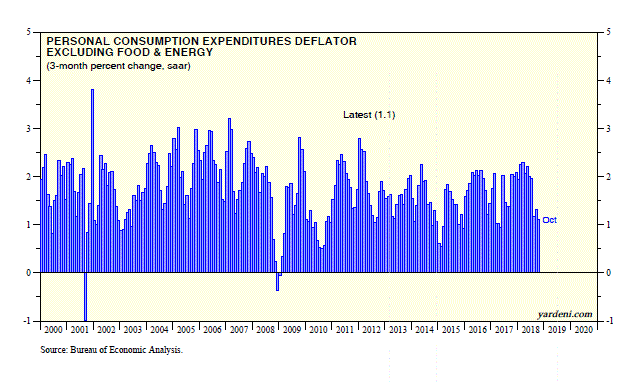
The Fed made lots of headlines last week. Evidence mounted that following another likely rate hike at the FOMC meeting on December 18-19, the monetary policy committee might pause during the first half of next year to reevaluate the course of monetary policy. Not as widely noticed last week was that inflationary pressures may be ebbing, which would also argue for a pause. Consider the following:
(1) PCED. While the labor market continues to tighten and wage gains are picking up, price inflation remains subdued according to the most currently available data. For starters, the core PCED rose 1.8% y/y during October, the lowest such pace since February (Fig. 1). Over the past three months through October, this measure is up just 1.1% (saar), the lowest reading since May 2017 (Fig. 2).
(2) Goods. The core PCED for goods fell -0.6% y/y during October (Fig. 3). The US import price index excluding energy has been moving higher since early 2017 after falling the previous two years. Nevertheless, it was up only 0.7% y/y during October, as a strong dollar this year mostly offset Trump’s tariffs.
(3) Services. The PCED for services excluding energy rose 2.6% y/y during October, an eight-month low (Fig. 4). Wireless telephone services prices fell sharply during 2017, but stabilized this year. So some of the upward pressure on inflation this year simply reflected much less deflation in this services category (Fig. 5).
(4) Rent. More importantly, the rate of inflation for rent of primary residences has been moderating over the past two years after rising sharply during most of the current expansion (Fig. 6). It was still high at 3.6% during October. But the boom in multi-family housing construction in recent years may be closing the gap between the demand and the supply of rental housing units.
(5) Medical care. Of even greater importance may be what is happening to prices in the health care industry. They aren’t rising much at all (Fig. 7). Over the past 12 months through October, the PCED for medical care is up just 1.3%, with hospital and physician services up only 1.5% and 0.7%, respectively, and prescription drug prices up just 0.8%! The moderation in the latter might reflect pressure from the Trump administration on drug companies to keep a lid on their prices. The services components of health care may finally be experiencing long-overdue upturns in their productivity, which may be a long-term phenomenon as new competitors—most notably Amazon—enter the field.
(6) Regional price surveys. Five of the Fed’s regional district banks include questions on prices paid and prices received in their monthly surveys. I monitor the averages of each of these two series (Fig. 8). Both peaked during July and have been edging down since then through November.
(7) Oil. Helping to moderate inflationary expectations has been the recent 31% plunge in the price of a barrel of Brent crude oil since October 3 through Friday (Fig. 9). Technological innovation continues to disrupt the global oil industry, as US frackers are now producing almost 12.0mbd (Fig. 10). US crude oil exports have doubled since mid-January 2015 to 7.4mbd currently (Fig. 11).
(8) Real wages and productivity. Average hourly earnings rose 3.2% y/y during October, while the overall PCED rose 2.0% over the same period. As a result, inflation-adjusted wages rose to yet another record high (Fig. 12). This measure has been on a solid uptrend since the mid-1990s, blowing away the myth that real wages have stagnated for decades.
This couldn’t have been happening unless productivity has also been performing better than suggested by the data, which were revised higher for the late 1990s and may be revised higher for the current expansion, in our opinion. Another reason to believe that productivity is underestimated is that the S&P 500 profit margin, which we calculate from industry analysts’ consensus estimates for S&P 500 companies’ earnings and revenues, has been soaring to new record highs since late last year (Fig. 13). How did that happen if productivity has been as weak as widely believed? (It can’t all be explained by the cut in the corporate tax rate at the end of 2017.)
In an 11/27 speech, Fed Vice Chairman Richard Clarida acknowledged as much when he rhetorically asked: “What might explain why inflation is running at or close to the Federal Reserve's long-run objective of 2 percent, and not well above it, when growth is strong and the labor market robust?” He concluded that the answer might be that while “growth in aggregate demand in 2018 has been above the expected long-run growth rate in aggregate supply, it has not been exceeding this year's growth in actual aggregate supply.” The explanation is better-than-expected growth in productivity. If this keeps up, we will all be supply-siders.

